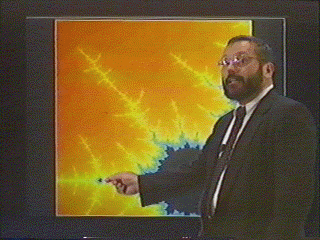Videos by Robert L. Devaney


This is a collection of twenty four 30 minute videos that give an introduction to differential equations emphasizing the modern visual approach, using a combination of computer graphics and dynamical systems approaches to understanding the behavior of differential equations.
Key Curriculum Press.
PO Box 2304, Berkeley, CA 94702
Phone: 800-995-MATH
This video is intended for use by high school students and their teachers. The seventy minute video is divided into two parts: a primer on iteration and a look at the mathematics behind the Mandelbrot set. The level of mathematics required to view the video is a knowledge of complex numbers: how to multiply them and how to plot them in the plane. During the video, students see some of the striking relationships between the Julia sets of quadratic functions and the geometry of the Mandelbrot set. Computer generated animations show how orbits and Julia sets change in shape as we travel in and around the Mandelbrot set.
Science TV. PO 598, Fort George Station,
New York, NY 10040
Phone: 212-569-8079
This video, aimed at advanced high school and beginning college students, explains some of the elementary ideas behind the concepts of chaos, fractals, and dynamical systems. Included are some of the lecturer's computer animations of exploding Julia sets.
Science TV. PO 598, Fort George Station,
New York, NY 10040
Phone: 212-569-8079
This video explores and explains two of the more fascinating images that arise in the study of Dynamical Systems, namely the orbit (or bifurcation) diagram and the Mandelbrot Set. Both of these images arise when a quadratic function is iterated, so the level of mathematical sophistication necessary to understand the lecture is minimal. The main goal of the lecture is to describe the relationship between these two images, how they are generated as well as what they mean mathematically. Several important related concepts in dynamical systems theory are also described, including period doubling bifurcations, Feigenbaum's number, Sarkovskii's Theorem and the role of critical orbits. The mathematical concepts are illustrated with colorful slides, films and computer experiments done in real time.
